HNC Business: Team Dynamics and Organisational Behaviour Report
VerifiedAdded on 2023/01/18
|11
|2904
|21
Report
AI Summary
This report examines team dynamics and organisational behaviour within the context of Curewell Hospital, a local hospital in London, UK. It explores the significance of teamwork for organisational success, differentiating between effective and ineffective teams. The report delves into group and team development theories, including Tuckman's stages of group development and Belbin's team roles. It assesses the impact of group dynamics on organisational performance and evaluates organisational philosophies and concepts that promote effective workplace behaviour, such as the path-goal and contingency theories. A comparative analysis of various theories and models is conducted to recommend the most suitable approaches for team building and organisational behaviour, with justifications provided. The research findings are analyzed to determine the effects of team-forming theories and organisational behaviour concepts on the workplace, culminating in a comprehensive conclusion that summarizes the key insights and recommendations. The report utilizes Harvard referencing to support its arguments and findings.
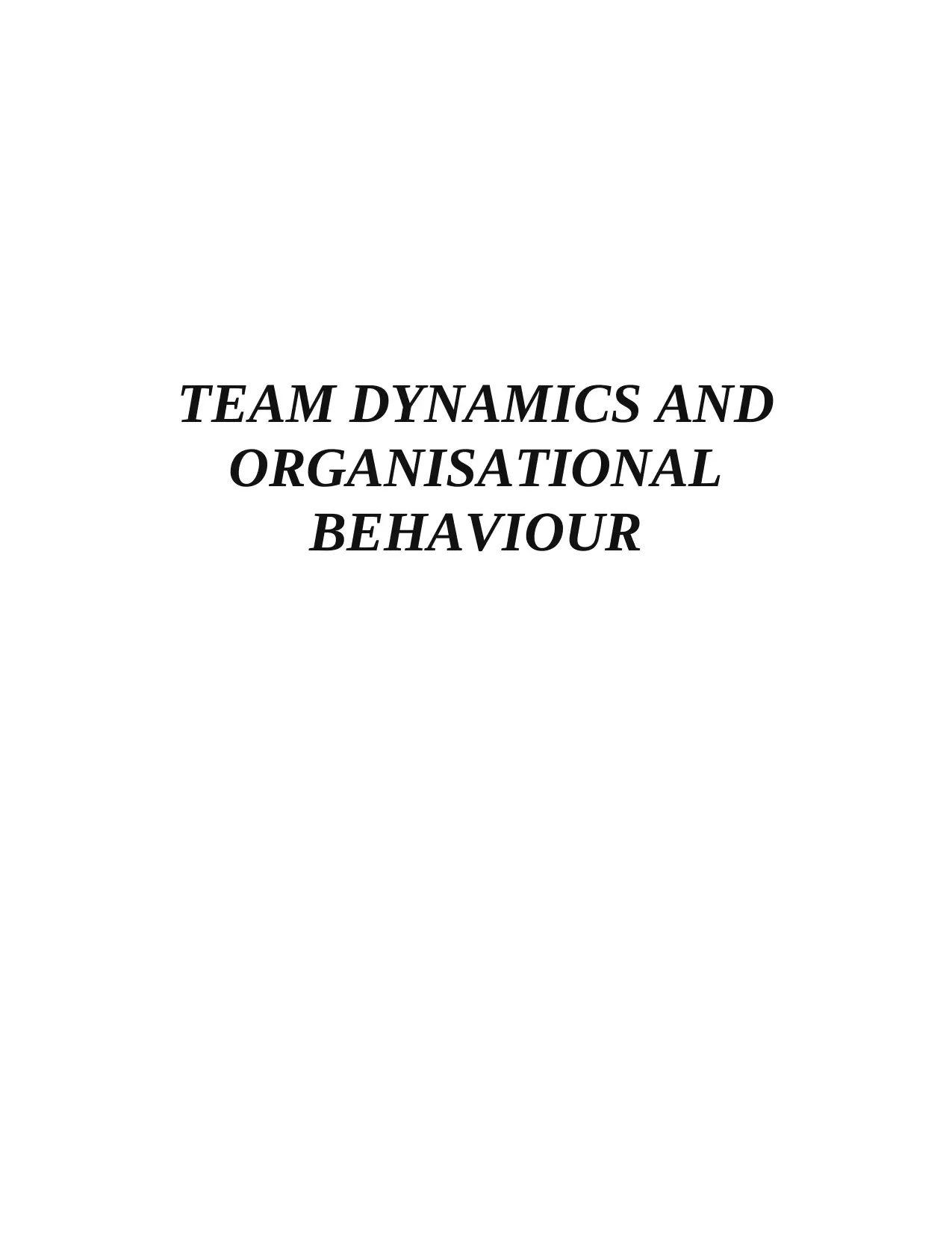
TEAM DYNAMICS AND
ORGANISATIONAL
BEHAVIOUR
ORGANISATIONAL
BEHAVIOUR
Paraphrase This Document
Need a fresh take? Get an instant paraphrase of this document with our AI Paraphraser
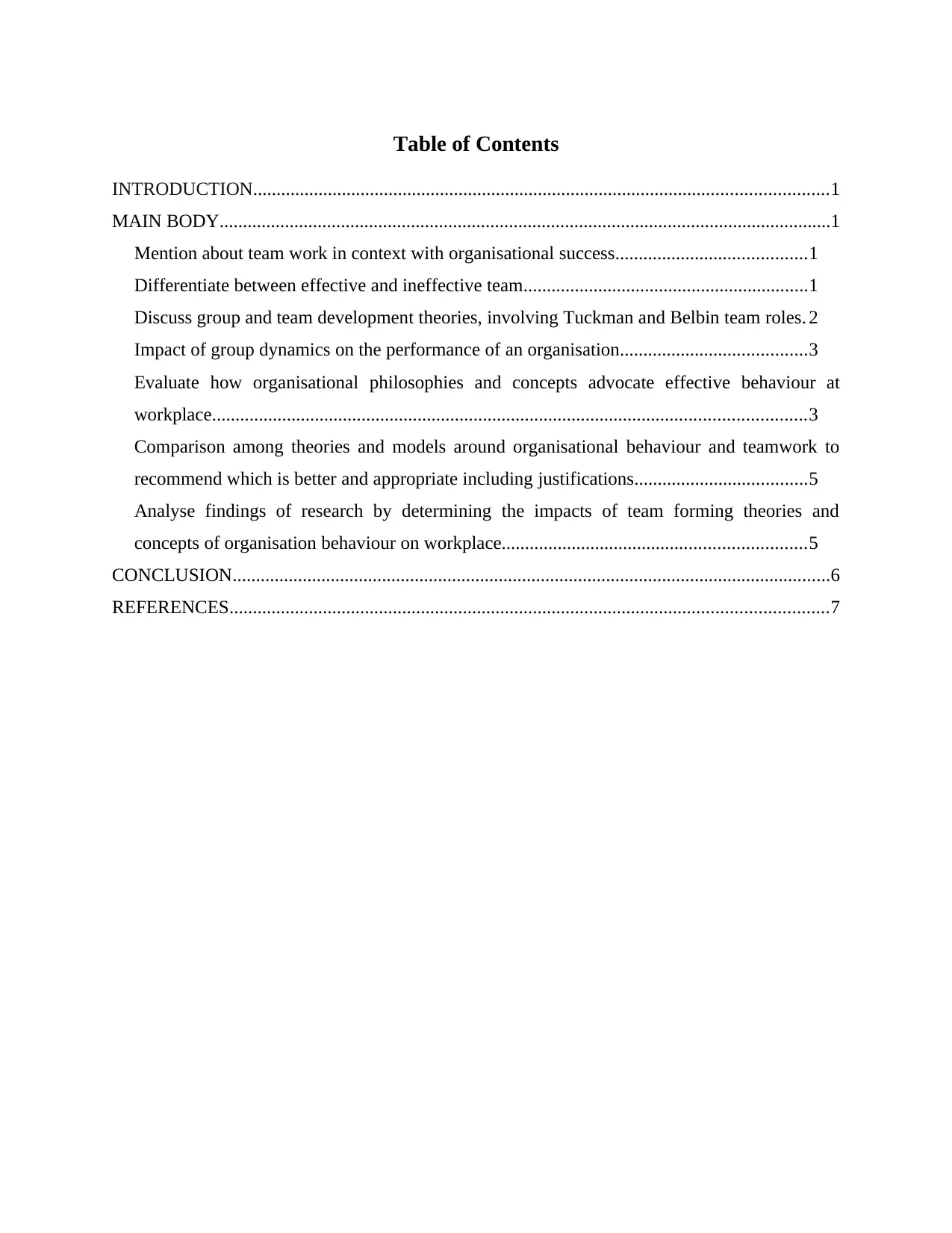
Table of Contents
INTRODUCTION...........................................................................................................................1
MAIN BODY...................................................................................................................................1
Mention about team work in context with organisational success.........................................1
Differentiate between effective and ineffective team.............................................................1
Discuss group and team development theories, involving Tuckman and Belbin team roles. 2
Impact of group dynamics on the performance of an organisation........................................3
Evaluate how organisational philosophies and concepts advocate effective behaviour at
workplace...............................................................................................................................3
Comparison among theories and models around organisational behaviour and teamwork to
recommend which is better and appropriate including justifications.....................................5
Analyse findings of research by determining the impacts of team forming theories and
concepts of organisation behaviour on workplace.................................................................5
CONCLUSION................................................................................................................................6
REFERENCES................................................................................................................................7
INTRODUCTION...........................................................................................................................1
MAIN BODY...................................................................................................................................1
Mention about team work in context with organisational success.........................................1
Differentiate between effective and ineffective team.............................................................1
Discuss group and team development theories, involving Tuckman and Belbin team roles. 2
Impact of group dynamics on the performance of an organisation........................................3
Evaluate how organisational philosophies and concepts advocate effective behaviour at
workplace...............................................................................................................................3
Comparison among theories and models around organisational behaviour and teamwork to
recommend which is better and appropriate including justifications.....................................5
Analyse findings of research by determining the impacts of team forming theories and
concepts of organisation behaviour on workplace.................................................................5
CONCLUSION................................................................................................................................6
REFERENCES................................................................................................................................7

⊘ This is a preview!⊘
Do you want full access?
Subscribe today to unlock all pages.

Trusted by 1+ million students worldwide
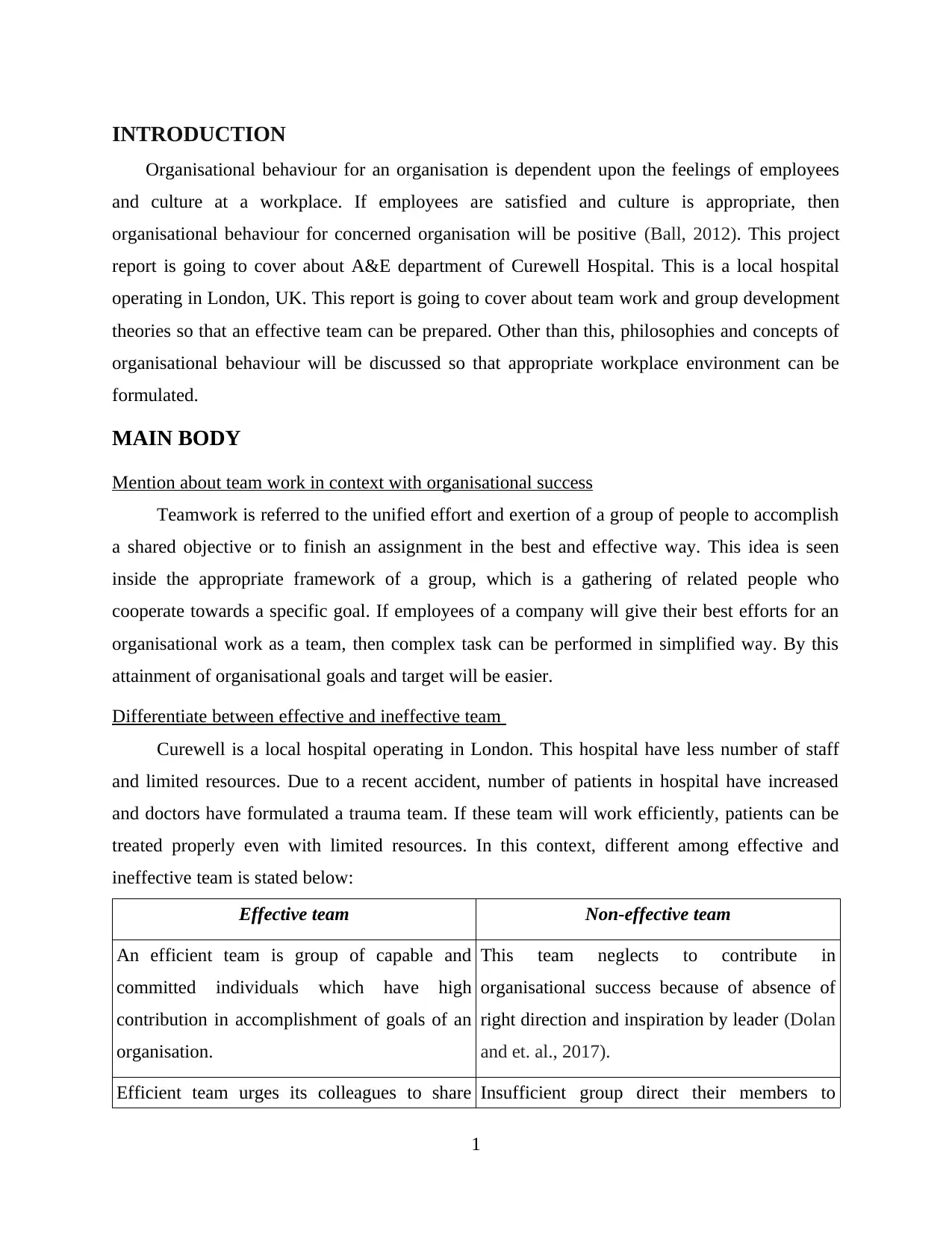
INTRODUCTION
Organisational behaviour for an organisation is dependent upon the feelings of employees
and culture at a workplace. If employees are satisfied and culture is appropriate, then
organisational behaviour for concerned organisation will be positive (Ball, 2012). This project
report is going to cover about A&E department of Curewell Hospital. This is a local hospital
operating in London, UK. This report is going to cover about team work and group development
theories so that an effective team can be prepared. Other than this, philosophies and concepts of
organisational behaviour will be discussed so that appropriate workplace environment can be
formulated.
MAIN BODY
Mention about team work in context with organisational success
Teamwork is referred to the unified effort and exertion of a group of people to accomplish
a shared objective or to finish an assignment in the best and effective way. This idea is seen
inside the appropriate framework of a group, which is a gathering of related people who
cooperate towards a specific goal. If employees of a company will give their best efforts for an
organisational work as a team, then complex task can be performed in simplified way. By this
attainment of organisational goals and target will be easier.
Differentiate between effective and ineffective team
Curewell is a local hospital operating in London. This hospital have less number of staff
and limited resources. Due to a recent accident, number of patients in hospital have increased
and doctors have formulated a trauma team. If these team will work efficiently, patients can be
treated properly even with limited resources. In this context, different among effective and
ineffective team is stated below:
Effective team Non-effective team
An efficient team is group of capable and
committed individuals which have high
contribution in accomplishment of goals of an
organisation.
This team neglects to contribute in
organisational success because of absence of
right direction and inspiration by leader (Dolan
and et. al., 2017).
Efficient team urges its colleagues to share Insufficient group direct their members to
1
Organisational behaviour for an organisation is dependent upon the feelings of employees
and culture at a workplace. If employees are satisfied and culture is appropriate, then
organisational behaviour for concerned organisation will be positive (Ball, 2012). This project
report is going to cover about A&E department of Curewell Hospital. This is a local hospital
operating in London, UK. This report is going to cover about team work and group development
theories so that an effective team can be prepared. Other than this, philosophies and concepts of
organisational behaviour will be discussed so that appropriate workplace environment can be
formulated.
MAIN BODY
Mention about team work in context with organisational success
Teamwork is referred to the unified effort and exertion of a group of people to accomplish
a shared objective or to finish an assignment in the best and effective way. This idea is seen
inside the appropriate framework of a group, which is a gathering of related people who
cooperate towards a specific goal. If employees of a company will give their best efforts for an
organisational work as a team, then complex task can be performed in simplified way. By this
attainment of organisational goals and target will be easier.
Differentiate between effective and ineffective team
Curewell is a local hospital operating in London. This hospital have less number of staff
and limited resources. Due to a recent accident, number of patients in hospital have increased
and doctors have formulated a trauma team. If these team will work efficiently, patients can be
treated properly even with limited resources. In this context, different among effective and
ineffective team is stated below:
Effective team Non-effective team
An efficient team is group of capable and
committed individuals which have high
contribution in accomplishment of goals of an
organisation.
This team neglects to contribute in
organisational success because of absence of
right direction and inspiration by leader (Dolan
and et. al., 2017).
Efficient team urges its colleagues to share Insufficient group direct their members to
1
Paraphrase This Document
Need a fresh take? Get an instant paraphrase of this document with our AI Paraphraser
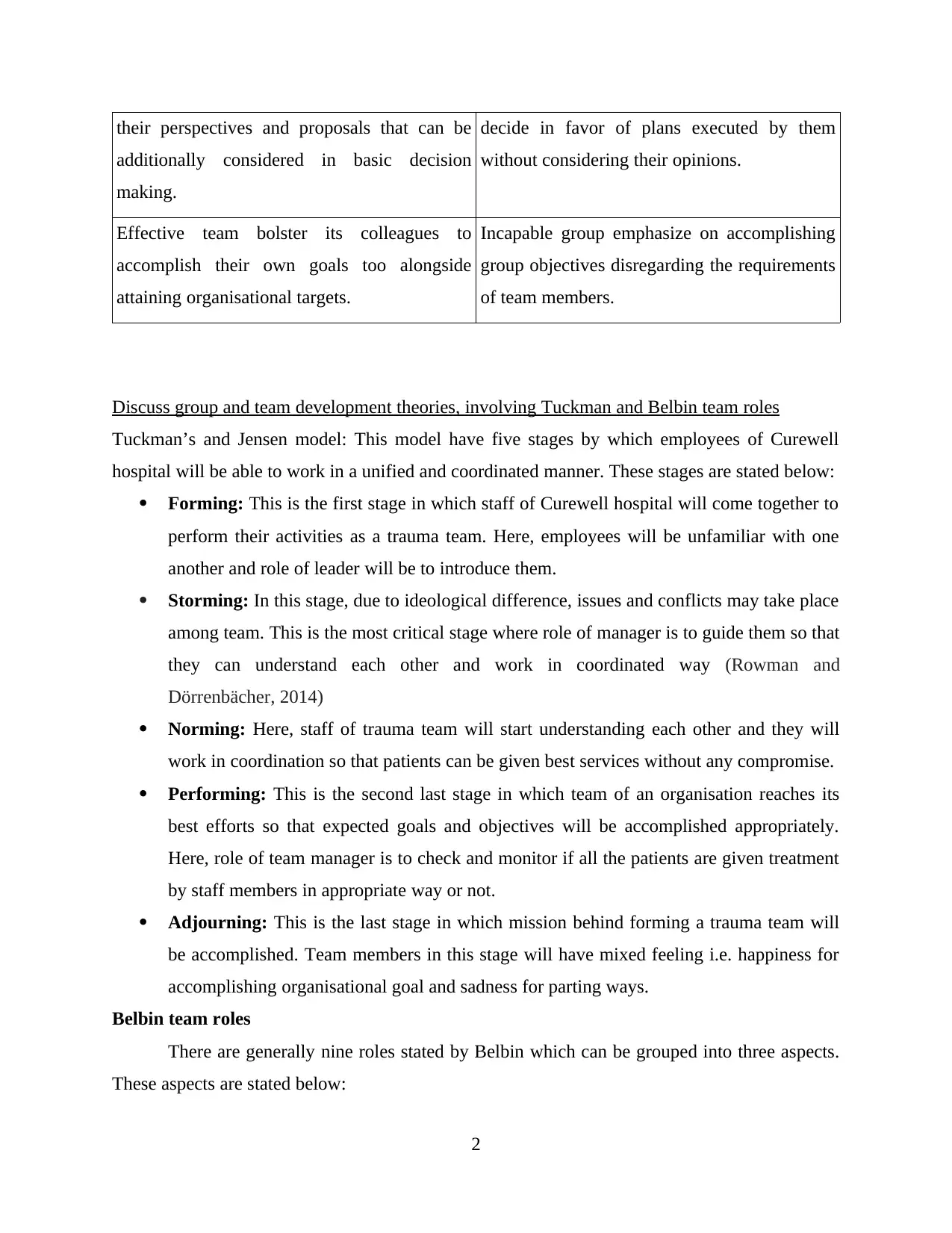
their perspectives and proposals that can be
additionally considered in basic decision
making.
decide in favor of plans executed by them
without considering their opinions.
Effective team bolster its colleagues to
accomplish their own goals too alongside
attaining organisational targets.
Incapable group emphasize on accomplishing
group objectives disregarding the requirements
of team members.
Discuss group and team development theories, involving Tuckman and Belbin team roles
Tuckman’s and Jensen model: This model have five stages by which employees of Curewell
hospital will be able to work in a unified and coordinated manner. These stages are stated below:
Forming: This is the first stage in which staff of Curewell hospital will come together to
perform their activities as a trauma team. Here, employees will be unfamiliar with one
another and role of leader will be to introduce them.
Storming: In this stage, due to ideological difference, issues and conflicts may take place
among team. This is the most critical stage where role of manager is to guide them so that
they can understand each other and work in coordinated way (Rowman and
Dörrenbächer, 2014)
Norming: Here, staff of trauma team will start understanding each other and they will
work in coordination so that patients can be given best services without any compromise.
Performing: This is the second last stage in which team of an organisation reaches its
best efforts so that expected goals and objectives will be accomplished appropriately.
Here, role of team manager is to check and monitor if all the patients are given treatment
by staff members in appropriate way or not.
Adjourning: This is the last stage in which mission behind forming a trauma team will
be accomplished. Team members in this stage will have mixed feeling i.e. happiness for
accomplishing organisational goal and sadness for parting ways.
Belbin team roles
There are generally nine roles stated by Belbin which can be grouped into three aspects.
These aspects are stated below:
2
additionally considered in basic decision
making.
decide in favor of plans executed by them
without considering their opinions.
Effective team bolster its colleagues to
accomplish their own goals too alongside
attaining organisational targets.
Incapable group emphasize on accomplishing
group objectives disregarding the requirements
of team members.
Discuss group and team development theories, involving Tuckman and Belbin team roles
Tuckman’s and Jensen model: This model have five stages by which employees of Curewell
hospital will be able to work in a unified and coordinated manner. These stages are stated below:
Forming: This is the first stage in which staff of Curewell hospital will come together to
perform their activities as a trauma team. Here, employees will be unfamiliar with one
another and role of leader will be to introduce them.
Storming: In this stage, due to ideological difference, issues and conflicts may take place
among team. This is the most critical stage where role of manager is to guide them so that
they can understand each other and work in coordinated way (Rowman and
Dörrenbächer, 2014)
Norming: Here, staff of trauma team will start understanding each other and they will
work in coordination so that patients can be given best services without any compromise.
Performing: This is the second last stage in which team of an organisation reaches its
best efforts so that expected goals and objectives will be accomplished appropriately.
Here, role of team manager is to check and monitor if all the patients are given treatment
by staff members in appropriate way or not.
Adjourning: This is the last stage in which mission behind forming a trauma team will
be accomplished. Team members in this stage will have mixed feeling i.e. happiness for
accomplishing organisational goal and sadness for parting ways.
Belbin team roles
There are generally nine roles stated by Belbin which can be grouped into three aspects.
These aspects are stated below:
2
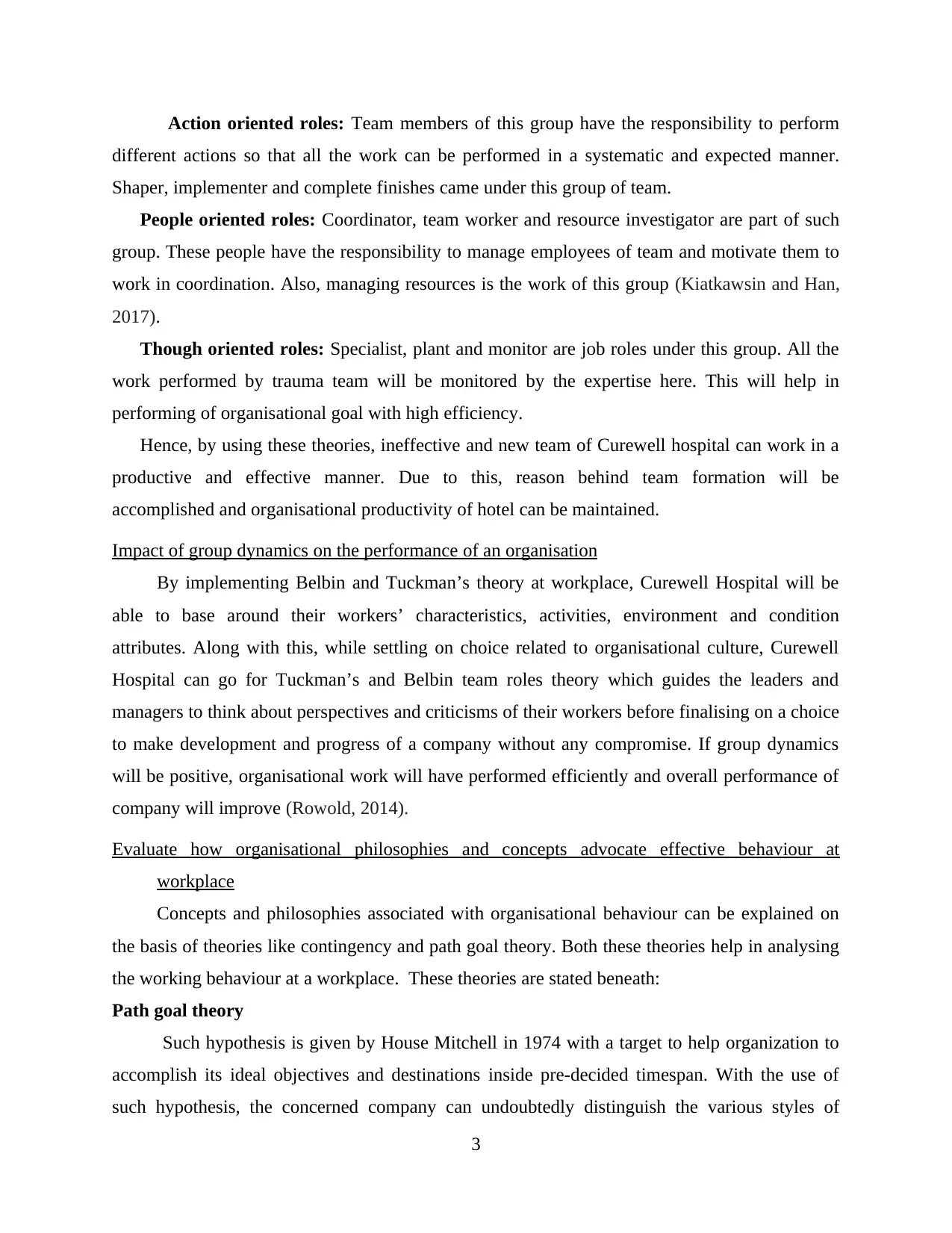
Action oriented roles: Team members of this group have the responsibility to perform
different actions so that all the work can be performed in a systematic and expected manner.
Shaper, implementer and complete finishes came under this group of team.
People oriented roles: Coordinator, team worker and resource investigator are part of such
group. These people have the responsibility to manage employees of team and motivate them to
work in coordination. Also, managing resources is the work of this group (Kiatkawsin and Han,
2017).
Though oriented roles: Specialist, plant and monitor are job roles under this group. All the
work performed by trauma team will be monitored by the expertise here. This will help in
performing of organisational goal with high efficiency.
Hence, by using these theories, ineffective and new team of Curewell hospital can work in a
productive and effective manner. Due to this, reason behind team formation will be
accomplished and organisational productivity of hotel can be maintained.
Impact of group dynamics on the performance of an organisation
By implementing Belbin and Tuckman’s theory at workplace, Curewell Hospital will be
able to base around their workers’ characteristics, activities, environment and condition
attributes. Along with this, while settling on choice related to organisational culture, Curewell
Hospital can go for Tuckman’s and Belbin team roles theory which guides the leaders and
managers to think about perspectives and criticisms of their workers before finalising on a choice
to make development and progress of a company without any compromise. If group dynamics
will be positive, organisational work will have performed efficiently and overall performance of
company will improve (Rowold, 2014).
Evaluate how organisational philosophies and concepts advocate effective behaviour at
workplace
Concepts and philosophies associated with organisational behaviour can be explained on
the basis of theories like contingency and path goal theory. Both these theories help in analysing
the working behaviour at a workplace. These theories are stated beneath:
Path goal theory
Such hypothesis is given by House Mitchell in 1974 with a target to help organization to
accomplish its ideal objectives and destinations inside pre-decided timespan. With the use of
such hypothesis, the concerned company can undoubtedly distinguish the various styles of
3
different actions so that all the work can be performed in a systematic and expected manner.
Shaper, implementer and complete finishes came under this group of team.
People oriented roles: Coordinator, team worker and resource investigator are part of such
group. These people have the responsibility to manage employees of team and motivate them to
work in coordination. Also, managing resources is the work of this group (Kiatkawsin and Han,
2017).
Though oriented roles: Specialist, plant and monitor are job roles under this group. All the
work performed by trauma team will be monitored by the expertise here. This will help in
performing of organisational goal with high efficiency.
Hence, by using these theories, ineffective and new team of Curewell hospital can work in a
productive and effective manner. Due to this, reason behind team formation will be
accomplished and organisational productivity of hotel can be maintained.
Impact of group dynamics on the performance of an organisation
By implementing Belbin and Tuckman’s theory at workplace, Curewell Hospital will be
able to base around their workers’ characteristics, activities, environment and condition
attributes. Along with this, while settling on choice related to organisational culture, Curewell
Hospital can go for Tuckman’s and Belbin team roles theory which guides the leaders and
managers to think about perspectives and criticisms of their workers before finalising on a choice
to make development and progress of a company without any compromise. If group dynamics
will be positive, organisational work will have performed efficiently and overall performance of
company will improve (Rowold, 2014).
Evaluate how organisational philosophies and concepts advocate effective behaviour at
workplace
Concepts and philosophies associated with organisational behaviour can be explained on
the basis of theories like contingency and path goal theory. Both these theories help in analysing
the working behaviour at a workplace. These theories are stated beneath:
Path goal theory
Such hypothesis is given by House Mitchell in 1974 with a target to help organization to
accomplish its ideal objectives and destinations inside pre-decided timespan. With the use of
such hypothesis, the concerned company can undoubtedly distinguish the various styles of
3
⊘ This is a preview!⊘
Do you want full access?
Subscribe today to unlock all pages.

Trusted by 1+ million students worldwide
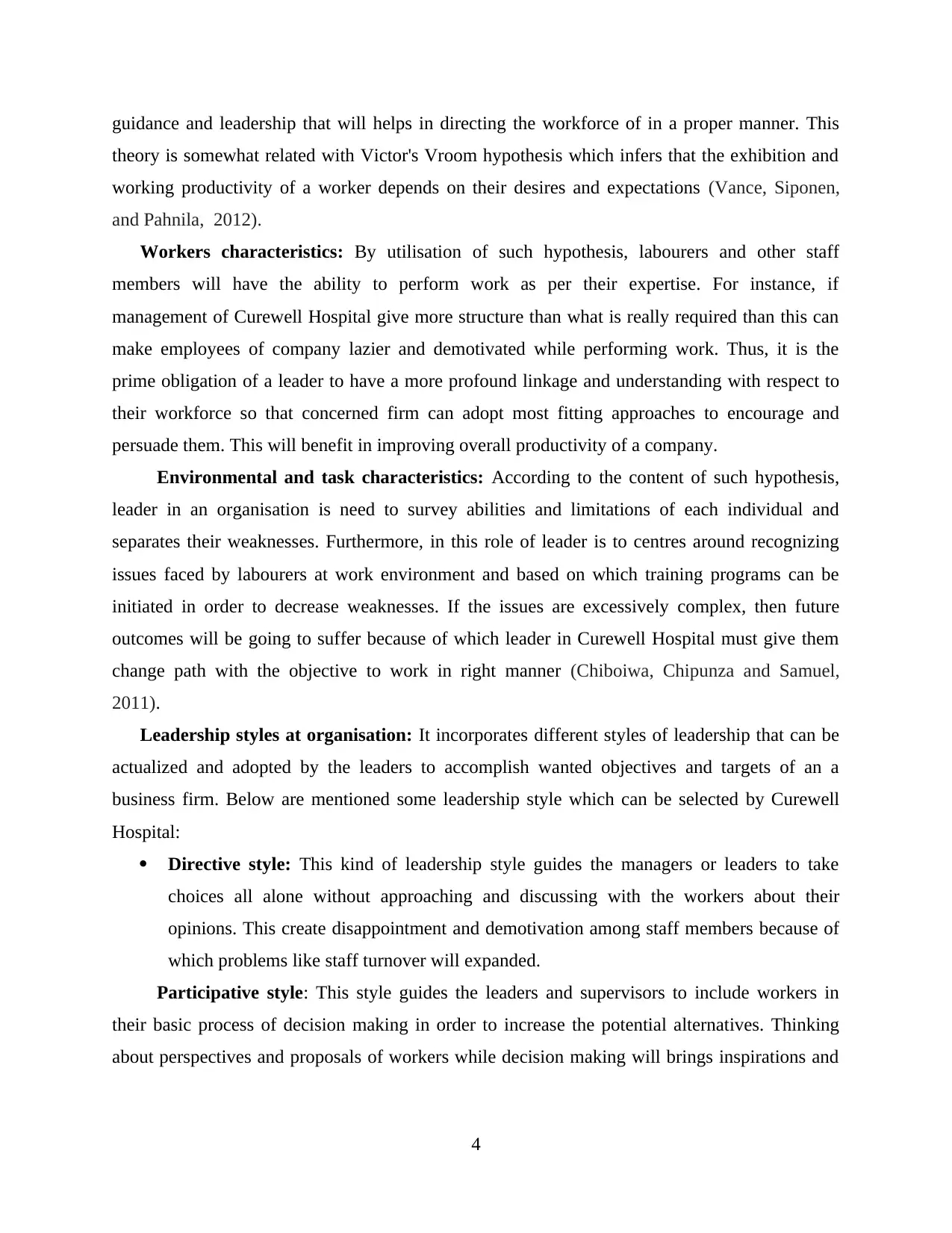
guidance and leadership that will helps in directing the workforce of in a proper manner. This
theory is somewhat related with Victor's Vroom hypothesis which infers that the exhibition and
working productivity of a worker depends on their desires and expectations (Vance, Siponen,
and Pahnila, 2012).
Workers characteristics: By utilisation of such hypothesis, labourers and other staff
members will have the ability to perform work as per their expertise. For instance, if
management of Curewell Hospital give more structure than what is really required than this can
make employees of company lazier and demotivated while performing work. Thus, it is the
prime obligation of a leader to have a more profound linkage and understanding with respect to
their workforce so that concerned firm can adopt most fitting approaches to encourage and
persuade them. This will benefit in improving overall productivity of a company.
Environmental and task characteristics: According to the content of such hypothesis,
leader in an organisation is need to survey abilities and limitations of each individual and
separates their weaknesses. Furthermore, in this role of leader is to centres around recognizing
issues faced by labourers at work environment and based on which training programs can be
initiated in order to decrease weaknesses. If the issues are excessively complex, then future
outcomes will be going to suffer because of which leader in Curewell Hospital must give them
change path with the objective to work in right manner (Chiboiwa, Chipunza and Samuel,
2011).
Leadership styles at organisation: It incorporates different styles of leadership that can be
actualized and adopted by the leaders to accomplish wanted objectives and targets of an a
business firm. Below are mentioned some leadership style which can be selected by Curewell
Hospital:
Directive style: This kind of leadership style guides the managers or leaders to take
choices all alone without approaching and discussing with the workers about their
opinions. This create disappointment and demotivation among staff members because of
which problems like staff turnover will expanded.
Participative style: This style guides the leaders and supervisors to include workers in
their basic process of decision making in order to increase the potential alternatives. Thinking
about perspectives and proposals of workers while decision making will brings inspirations and
4
theory is somewhat related with Victor's Vroom hypothesis which infers that the exhibition and
working productivity of a worker depends on their desires and expectations (Vance, Siponen,
and Pahnila, 2012).
Workers characteristics: By utilisation of such hypothesis, labourers and other staff
members will have the ability to perform work as per their expertise. For instance, if
management of Curewell Hospital give more structure than what is really required than this can
make employees of company lazier and demotivated while performing work. Thus, it is the
prime obligation of a leader to have a more profound linkage and understanding with respect to
their workforce so that concerned firm can adopt most fitting approaches to encourage and
persuade them. This will benefit in improving overall productivity of a company.
Environmental and task characteristics: According to the content of such hypothesis,
leader in an organisation is need to survey abilities and limitations of each individual and
separates their weaknesses. Furthermore, in this role of leader is to centres around recognizing
issues faced by labourers at work environment and based on which training programs can be
initiated in order to decrease weaknesses. If the issues are excessively complex, then future
outcomes will be going to suffer because of which leader in Curewell Hospital must give them
change path with the objective to work in right manner (Chiboiwa, Chipunza and Samuel,
2011).
Leadership styles at organisation: It incorporates different styles of leadership that can be
actualized and adopted by the leaders to accomplish wanted objectives and targets of an a
business firm. Below are mentioned some leadership style which can be selected by Curewell
Hospital:
Directive style: This kind of leadership style guides the managers or leaders to take
choices all alone without approaching and discussing with the workers about their
opinions. This create disappointment and demotivation among staff members because of
which problems like staff turnover will expanded.
Participative style: This style guides the leaders and supervisors to include workers in
their basic process of decision making in order to increase the potential alternatives. Thinking
about perspectives and proposals of workers while decision making will brings inspirations and
4
Paraphrase This Document
Need a fresh take? Get an instant paraphrase of this document with our AI Paraphraser
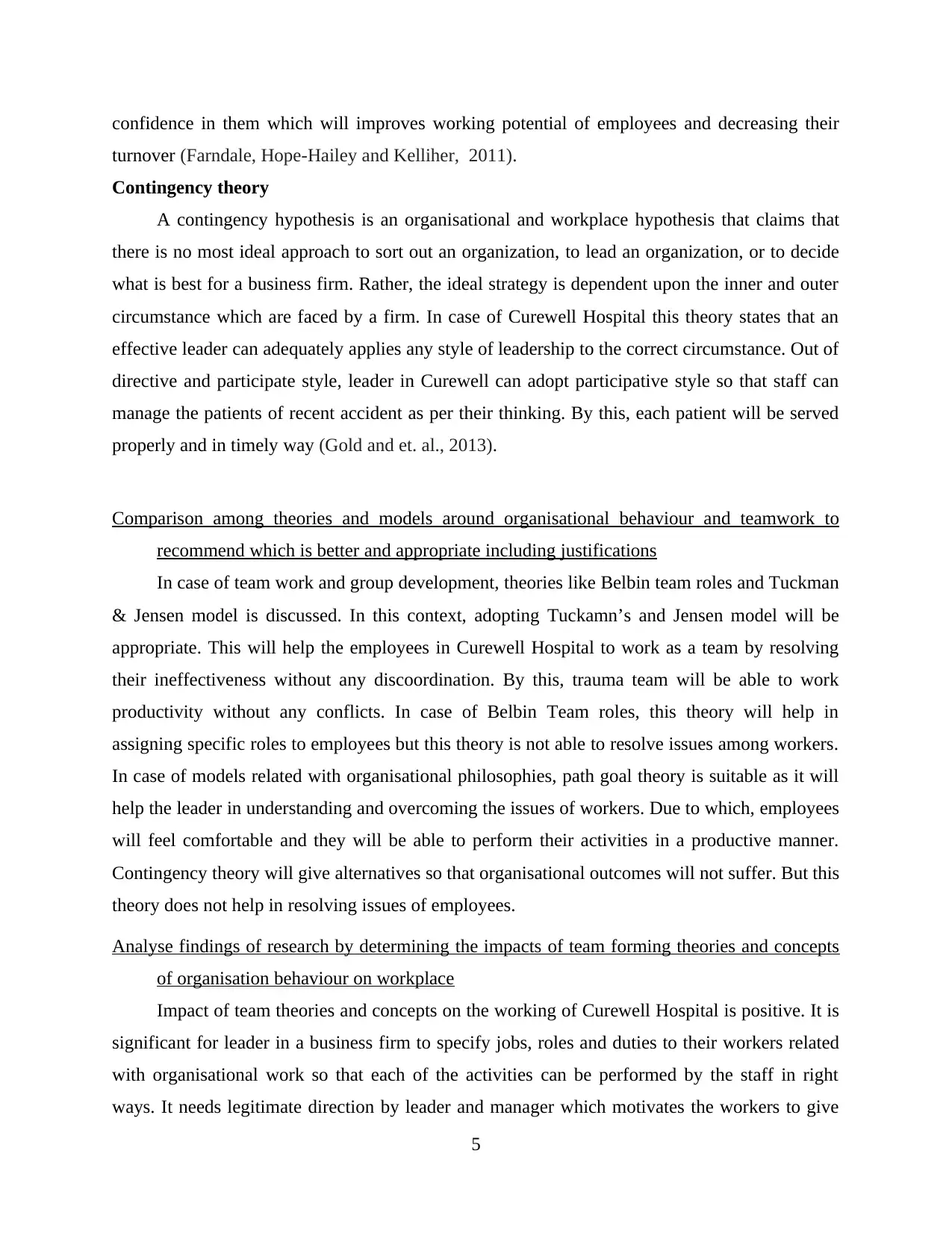
confidence in them which will improves working potential of employees and decreasing their
turnover (Farndale, Hope-Hailey and Kelliher, 2011).
Contingency theory
A contingency hypothesis is an organisational and workplace hypothesis that claims that
there is no most ideal approach to sort out an organization, to lead an organization, or to decide
what is best for a business firm. Rather, the ideal strategy is dependent upon the inner and outer
circumstance which are faced by a firm. In case of Curewell Hospital this theory states that an
effective leader can adequately applies any style of leadership to the correct circumstance. Out of
directive and participate style, leader in Curewell can adopt participative style so that staff can
manage the patients of recent accident as per their thinking. By this, each patient will be served
properly and in timely way (Gold and et. al., 2013).
Comparison among theories and models around organisational behaviour and teamwork to
recommend which is better and appropriate including justifications
In case of team work and group development, theories like Belbin team roles and Tuckman
& Jensen model is discussed. In this context, adopting Tuckamn’s and Jensen model will be
appropriate. This will help the employees in Curewell Hospital to work as a team by resolving
their ineffectiveness without any discoordination. By this, trauma team will be able to work
productivity without any conflicts. In case of Belbin Team roles, this theory will help in
assigning specific roles to employees but this theory is not able to resolve issues among workers.
In case of models related with organisational philosophies, path goal theory is suitable as it will
help the leader in understanding and overcoming the issues of workers. Due to which, employees
will feel comfortable and they will be able to perform their activities in a productive manner.
Contingency theory will give alternatives so that organisational outcomes will not suffer. But this
theory does not help in resolving issues of employees.
Analyse findings of research by determining the impacts of team forming theories and concepts
of organisation behaviour on workplace
Impact of team theories and concepts on the working of Curewell Hospital is positive. It is
significant for leader in a business firm to specify jobs, roles and duties to their workers related
with organisational work so that each of the activities can be performed by the staff in right
ways. It needs legitimate direction by leader and manager which motivates the workers to give
5
turnover (Farndale, Hope-Hailey and Kelliher, 2011).
Contingency theory
A contingency hypothesis is an organisational and workplace hypothesis that claims that
there is no most ideal approach to sort out an organization, to lead an organization, or to decide
what is best for a business firm. Rather, the ideal strategy is dependent upon the inner and outer
circumstance which are faced by a firm. In case of Curewell Hospital this theory states that an
effective leader can adequately applies any style of leadership to the correct circumstance. Out of
directive and participate style, leader in Curewell can adopt participative style so that staff can
manage the patients of recent accident as per their thinking. By this, each patient will be served
properly and in timely way (Gold and et. al., 2013).
Comparison among theories and models around organisational behaviour and teamwork to
recommend which is better and appropriate including justifications
In case of team work and group development, theories like Belbin team roles and Tuckman
& Jensen model is discussed. In this context, adopting Tuckamn’s and Jensen model will be
appropriate. This will help the employees in Curewell Hospital to work as a team by resolving
their ineffectiveness without any discoordination. By this, trauma team will be able to work
productivity without any conflicts. In case of Belbin Team roles, this theory will help in
assigning specific roles to employees but this theory is not able to resolve issues among workers.
In case of models related with organisational philosophies, path goal theory is suitable as it will
help the leader in understanding and overcoming the issues of workers. Due to which, employees
will feel comfortable and they will be able to perform their activities in a productive manner.
Contingency theory will give alternatives so that organisational outcomes will not suffer. But this
theory does not help in resolving issues of employees.
Analyse findings of research by determining the impacts of team forming theories and concepts
of organisation behaviour on workplace
Impact of team theories and concepts on the working of Curewell Hospital is positive. It is
significant for leader in a business firm to specify jobs, roles and duties to their workers related
with organisational work so that each of the activities can be performed by the staff in right
ways. It needs legitimate direction by leader and manager which motivates the workers to give
5
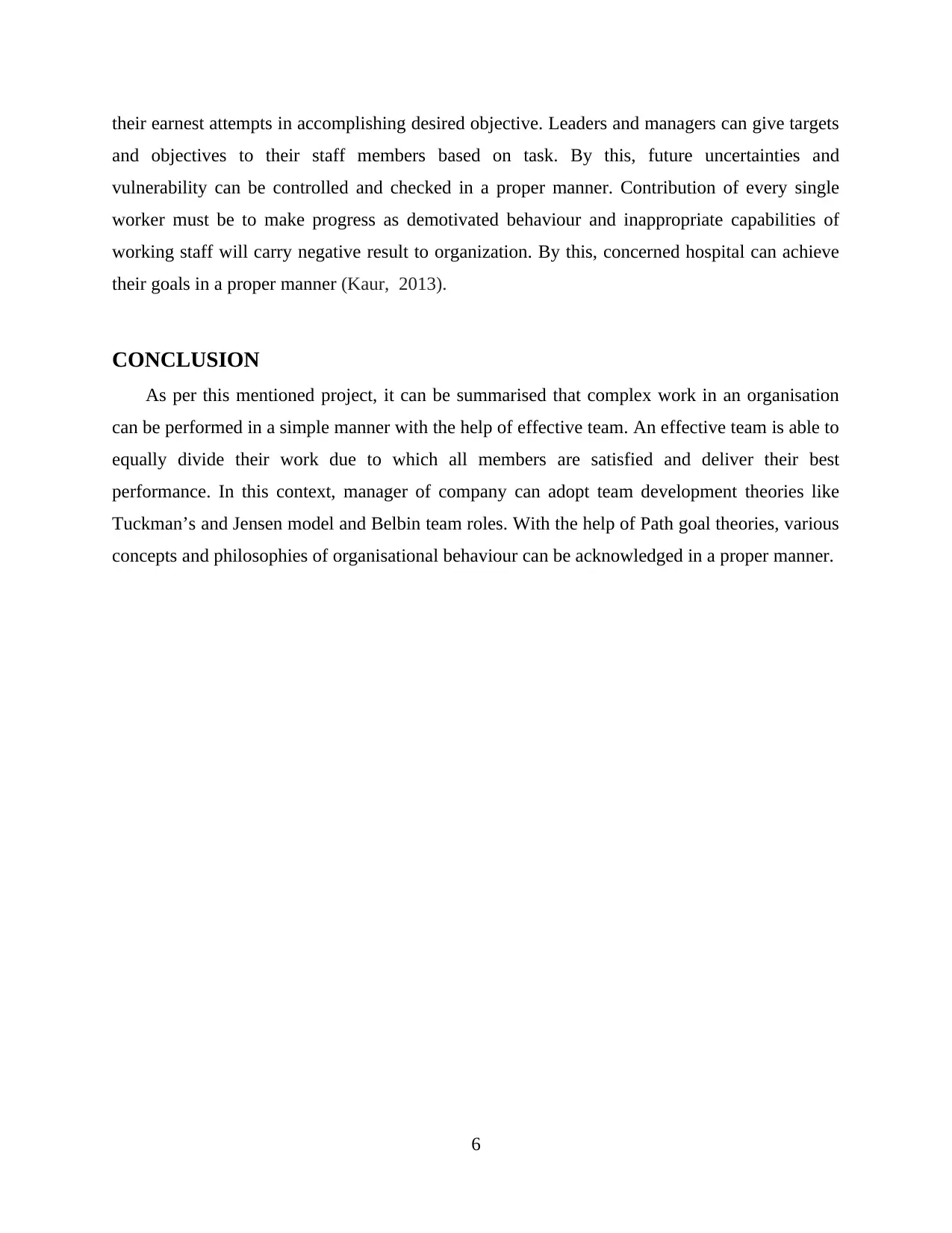
their earnest attempts in accomplishing desired objective. Leaders and managers can give targets
and objectives to their staff members based on task. By this, future uncertainties and
vulnerability can be controlled and checked in a proper manner. Contribution of every single
worker must be to make progress as demotivated behaviour and inappropriate capabilities of
working staff will carry negative result to organization. By this, concerned hospital can achieve
their goals in a proper manner (Kaur, 2013).
CONCLUSION
As per this mentioned project, it can be summarised that complex work in an organisation
can be performed in a simple manner with the help of effective team. An effective team is able to
equally divide their work due to which all members are satisfied and deliver their best
performance. In this context, manager of company can adopt team development theories like
Tuckman’s and Jensen model and Belbin team roles. With the help of Path goal theories, various
concepts and philosophies of organisational behaviour can be acknowledged in a proper manner.
6
and objectives to their staff members based on task. By this, future uncertainties and
vulnerability can be controlled and checked in a proper manner. Contribution of every single
worker must be to make progress as demotivated behaviour and inappropriate capabilities of
working staff will carry negative result to organization. By this, concerned hospital can achieve
their goals in a proper manner (Kaur, 2013).
CONCLUSION
As per this mentioned project, it can be summarised that complex work in an organisation
can be performed in a simple manner with the help of effective team. An effective team is able to
equally divide their work due to which all members are satisfied and deliver their best
performance. In this context, manager of company can adopt team development theories like
Tuckman’s and Jensen model and Belbin team roles. With the help of Path goal theories, various
concepts and philosophies of organisational behaviour can be acknowledged in a proper manner.
6
⊘ This is a preview!⊘
Do you want full access?
Subscribe today to unlock all pages.

Trusted by 1+ million students worldwide
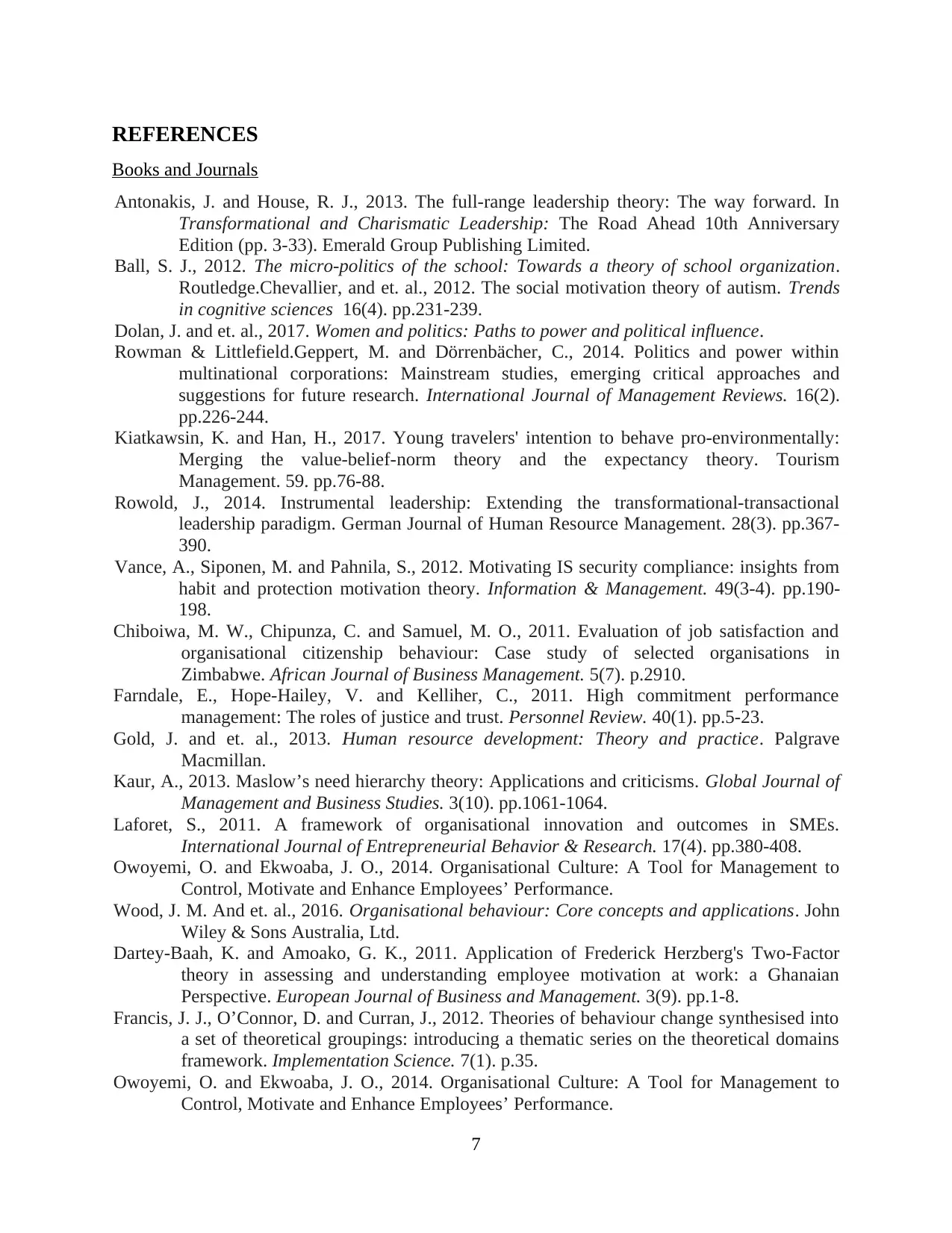
REFERENCES
Books and Journals
Antonakis, J. and House, R. J., 2013. The full-range leadership theory: The way forward. In
Transformational and Charismatic Leadership: The Road Ahead 10th Anniversary
Edition (pp. 3-33). Emerald Group Publishing Limited.
Ball, S. J., 2012. The micro-politics of the school: Towards a theory of school organization.
Routledge.Chevallier, and et. al., 2012. The social motivation theory of autism. Trends
in cognitive sciences 16(4). pp.231-239.
Dolan, J. and et. al., 2017. Women and politics: Paths to power and political influence.
Rowman & Littlefield.Geppert, M. and Dörrenbächer, C., 2014. Politics and power within
multinational corporations: Mainstream studies, emerging critical approaches and
suggestions for future research. International Journal of Management Reviews. 16(2).
pp.226-244.
Kiatkawsin, K. and Han, H., 2017. Young travelers' intention to behave pro-environmentally:
Merging the value-belief-norm theory and the expectancy theory. Tourism
Management. 59. pp.76-88.
Rowold, J., 2014. Instrumental leadership: Extending the transformational-transactional
leadership paradigm. German Journal of Human Resource Management. 28(3). pp.367-
390.
Vance, A., Siponen, M. and Pahnila, S., 2012. Motivating IS security compliance: insights from
habit and protection motivation theory. Information & Management. 49(3-4). pp.190-
198.
Chiboiwa, M. W., Chipunza, C. and Samuel, M. O., 2011. Evaluation of job satisfaction and
organisational citizenship behaviour: Case study of selected organisations in
Zimbabwe. African Journal of Business Management. 5(7). p.2910.
Farndale, E., Hope-Hailey, V. and Kelliher, C., 2011. High commitment performance
management: The roles of justice and trust. Personnel Review. 40(1). pp.5-23.
Gold, J. and et. al., 2013. Human resource development: Theory and practice. Palgrave
Macmillan.
Kaur, A., 2013. Maslow’s need hierarchy theory: Applications and criticisms. Global Journal of
Management and Business Studies. 3(10). pp.1061-1064.
Laforet, S., 2011. A framework of organisational innovation and outcomes in SMEs.
International Journal of Entrepreneurial Behavior & Research. 17(4). pp.380-408.
Owoyemi, O. and Ekwoaba, J. O., 2014. Organisational Culture: A Tool for Management to
Control, Motivate and Enhance Employees’ Performance.
Wood, J. M. And et. al., 2016. Organisational behaviour: Core concepts and applications. John
Wiley & Sons Australia, Ltd.
Dartey-Baah, K. and Amoako, G. K., 2011. Application of Frederick Herzberg's Two-Factor
theory in assessing and understanding employee motivation at work: a Ghanaian
Perspective. European Journal of Business and Management. 3(9). pp.1-8.
Francis, J. J., O’Connor, D. and Curran, J., 2012. Theories of behaviour change synthesised into
a set of theoretical groupings: introducing a thematic series on the theoretical domains
framework. Implementation Science. 7(1). p.35.
Owoyemi, O. and Ekwoaba, J. O., 2014. Organisational Culture: A Tool for Management to
Control, Motivate and Enhance Employees’ Performance.
7
Books and Journals
Antonakis, J. and House, R. J., 2013. The full-range leadership theory: The way forward. In
Transformational and Charismatic Leadership: The Road Ahead 10th Anniversary
Edition (pp. 3-33). Emerald Group Publishing Limited.
Ball, S. J., 2012. The micro-politics of the school: Towards a theory of school organization.
Routledge.Chevallier, and et. al., 2012. The social motivation theory of autism. Trends
in cognitive sciences 16(4). pp.231-239.
Dolan, J. and et. al., 2017. Women and politics: Paths to power and political influence.
Rowman & Littlefield.Geppert, M. and Dörrenbächer, C., 2014. Politics and power within
multinational corporations: Mainstream studies, emerging critical approaches and
suggestions for future research. International Journal of Management Reviews. 16(2).
pp.226-244.
Kiatkawsin, K. and Han, H., 2017. Young travelers' intention to behave pro-environmentally:
Merging the value-belief-norm theory and the expectancy theory. Tourism
Management. 59. pp.76-88.
Rowold, J., 2014. Instrumental leadership: Extending the transformational-transactional
leadership paradigm. German Journal of Human Resource Management. 28(3). pp.367-
390.
Vance, A., Siponen, M. and Pahnila, S., 2012. Motivating IS security compliance: insights from
habit and protection motivation theory. Information & Management. 49(3-4). pp.190-
198.
Chiboiwa, M. W., Chipunza, C. and Samuel, M. O., 2011. Evaluation of job satisfaction and
organisational citizenship behaviour: Case study of selected organisations in
Zimbabwe. African Journal of Business Management. 5(7). p.2910.
Farndale, E., Hope-Hailey, V. and Kelliher, C., 2011. High commitment performance
management: The roles of justice and trust. Personnel Review. 40(1). pp.5-23.
Gold, J. and et. al., 2013. Human resource development: Theory and practice. Palgrave
Macmillan.
Kaur, A., 2013. Maslow’s need hierarchy theory: Applications and criticisms. Global Journal of
Management and Business Studies. 3(10). pp.1061-1064.
Laforet, S., 2011. A framework of organisational innovation and outcomes in SMEs.
International Journal of Entrepreneurial Behavior & Research. 17(4). pp.380-408.
Owoyemi, O. and Ekwoaba, J. O., 2014. Organisational Culture: A Tool for Management to
Control, Motivate and Enhance Employees’ Performance.
Wood, J. M. And et. al., 2016. Organisational behaviour: Core concepts and applications. John
Wiley & Sons Australia, Ltd.
Dartey-Baah, K. and Amoako, G. K., 2011. Application of Frederick Herzberg's Two-Factor
theory in assessing and understanding employee motivation at work: a Ghanaian
Perspective. European Journal of Business and Management. 3(9). pp.1-8.
Francis, J. J., O’Connor, D. and Curran, J., 2012. Theories of behaviour change synthesised into
a set of theoretical groupings: introducing a thematic series on the theoretical domains
framework. Implementation Science. 7(1). p.35.
Owoyemi, O. and Ekwoaba, J. O., 2014. Organisational Culture: A Tool for Management to
Control, Motivate and Enhance Employees’ Performance.
7
Paraphrase This Document
Need a fresh take? Get an instant paraphrase of this document with our AI Paraphraser

8
1 out of 11
Related Documents
Your All-in-One AI-Powered Toolkit for Academic Success.
+13062052269
info@desklib.com
Available 24*7 on WhatsApp / Email
![[object Object]](/_next/static/media/star-bottom.7253800d.svg)
Unlock your academic potential
Copyright © 2020–2025 A2Z Services. All Rights Reserved. Developed and managed by ZUCOL.





